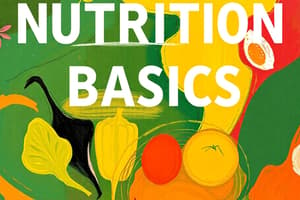Podcast
Questions and Answers
What is the primary function of nutrients in the body?
What is the primary function of nutrients in the body?
- To enhance flavor of foods
- To increase the size of food items
- To provide energy and support bodily functions (correct)
- To provide color to foods
Which of the following best describes food?
Which of the following best describes food?
- Any substance that nourishes the body when ingested (correct)
- A mixture of nutrients and non-nutrients
- An organic substance that enhances taste
- A product created exclusively from plant materials
In the context of nutrition, what does 'homeostasis' refer to?
In the context of nutrition, what does 'homeostasis' refer to?
- The digestion of food in the stomach
- The regulation of bodily functions to maintain balance (correct)
- A process that creates energy from food
- The absorption of vitamins and minerals
Nutrients are classified according to several criteria. Which of the following is NOT one of those criteria?
Nutrients are classified according to several criteria. Which of the following is NOT one of those criteria?
What defines overweight in adults based on Body Mass Index (BMI)?
What defines overweight in adults based on Body Mass Index (BMI)?
What are 'go foods' primarily responsible for?
What are 'go foods' primarily responsible for?
Which of the following is considered a diet-related noncommunicable disease (NCD)?
Which of the following is considered a diet-related noncommunicable disease (NCD)?
Which nutrient deficiencies are considered a major threat to health and development worldwide?
Which nutrient deficiencies are considered a major threat to health and development worldwide?
Which function do 'grow foods' serve in nutrition?
Which function do 'grow foods' serve in nutrition?
What role do enzymes play in the body?
What role do enzymes play in the body?
What is the definition of imbalance nutrition?
What is the definition of imbalance nutrition?
Which type of nutrients is specifically categorized as 'glow food'?
Which type of nutrients is specifically categorized as 'glow food'?
Dietary standards are comprised of what?
Dietary standards are comprised of what?
What are dietary requirements primarily based on?
What are dietary requirements primarily based on?
What is the primary cause of the global increase in obesity rates?
What is the primary cause of the global increase in obesity rates?
Which of the following correctly describes micronutrients?
Which of the following correctly describes micronutrients?
What are the primary components of an enzyme system?
What are the primary components of an enzyme system?
Which suffix is commonly used to indicate the presence of an enzyme?
Which suffix is commonly used to indicate the presence of an enzyme?
What does malnutrition primarily refer to?
What does malnutrition primarily refer to?
Which of the following is NOT a sub-form of undernutrition?
Which of the following is NOT a sub-form of undernutrition?
Which condition is associated with low weight-for-height?
Which condition is associated with low weight-for-height?
What is a characteristic of overnutrition?
What is a characteristic of overnutrition?
What classification can a person with good nutritional status have?
What classification can a person with good nutritional status have?
Children who are underweight may also be experiencing which conditions?
Children who are underweight may also be experiencing which conditions?
What does REI/RNI stand for in nutrition and health?
What does REI/RNI stand for in nutrition and health?
Which of the following best describes food quality?
Which of the following best describes food quality?
Which factor is NOT part of the established requirements relating to food quality?
Which factor is NOT part of the established requirements relating to food quality?
Which of the following is considered an environmental factor affecting food choices?
Which of the following is considered an environmental factor affecting food choices?
What does the extent of food's 'shelf-life stability' refer to?
What does the extent of food's 'shelf-life stability' refer to?
Which characteristic does NOT contribute to the identity of a food in relation to a standard?
Which characteristic does NOT contribute to the identity of a food in relation to a standard?
What is meant by 'fitness for use' in the context of food quality?
What is meant by 'fitness for use' in the context of food quality?
Which of the following options is NOT an individual-level factor influencing food choices?
Which of the following options is NOT an individual-level factor influencing food choices?
Flashcards are hidden until you start studying
Study Notes
Definition and Overview
- Nutrition integrates knowledge to maintain well-being from birth to death through effective education.
- Nutrition is the science studying the composition of food, nutrients, and their impact on health.
- Food nourishes the body, aiding in tissue repair, energy supply, and regulation of bodily processes.
Key Nutritional Components
- Nutrients are essential chemicals that serve three main functions:
- Provide energy for biochemical reactions.
- Build and repair tissues, including organs and bones.
- Regulate life processes for homeostasis.
- Classifications of nutrients include:
- Energy-providing (Go Food).
- Body-building (Grow Food).
- Body-regulating (Glow Food).
Nutritional Status
- Nutritional status (nutriture) reflects the body's condition based on nutrient utilization.
- Categories include:
- Optimum or good nutrition: Adequate supply and effective use of essential nutrients.
- Malnutrition: Includes undernutrition (deficiencies), overnutrition (excesses), and nutrient imbalances.
Malnutrition and Its Forms
- Malnutrition refers to imbalances in nutrient intake leading to health issues.
- Forms include:
- Undernutrition: Insufficient intake, leading to wasting (low weight-for-height), stunting (low height-for-age), underweight, and deficiencies.
- Overnutrition: Excessive energy intake leading to overweight or obesity, classified using Body Mass Index (BMI).
Overnutrition
- Overweight defined as a BMI of 25+, obesity as a BMI of 30+.
- Associated with diet-related noncommunicable diseases (NCDs) such as cardiovascular diseases, certain cancers, and diabetes.
Micronutrient Malnutrition
- Deficiencies in vitamins and minerals can hinder the body's ability to produce essential enzymes and hormones.
- Common deficiencies include iodine, vitamin A, and iron, crucial for global health, especially in low-income populations.
Imbalance Nutrition
- A pathological state results from disproportions among essential nutrients, affecting metabolic needs without absolute deficiencies.
Dietary Standards
- Provide nutrient requirements for good health specific to age, sex, weight, and physical activity.
- Recommended Energy/Nutrient Intake (REI/RNI) serves as guidelines for maintaining health.
Food Quality
- Defined as the degree of excellence based on consumer satisfaction and fitness for consumption.
- Factors determining food quality include:
- Identity and quantity of food.
- Sensory attributes (taste, texture).
- Shelf-life stability, wholesomeness, and packaging.
Factors That Affect Food Choices
- Environmental factors:
- Macro-level includes broader societal influences.
- Physical environment affects where food is procured or consumed.
- Social environment influences preferences and availability.
- Individual-level factors shape personal food choices based on personal preferences and experiences.
Studying That Suits You
Use AI to generate personalized quizzes and flashcards to suit your learning preferences.




